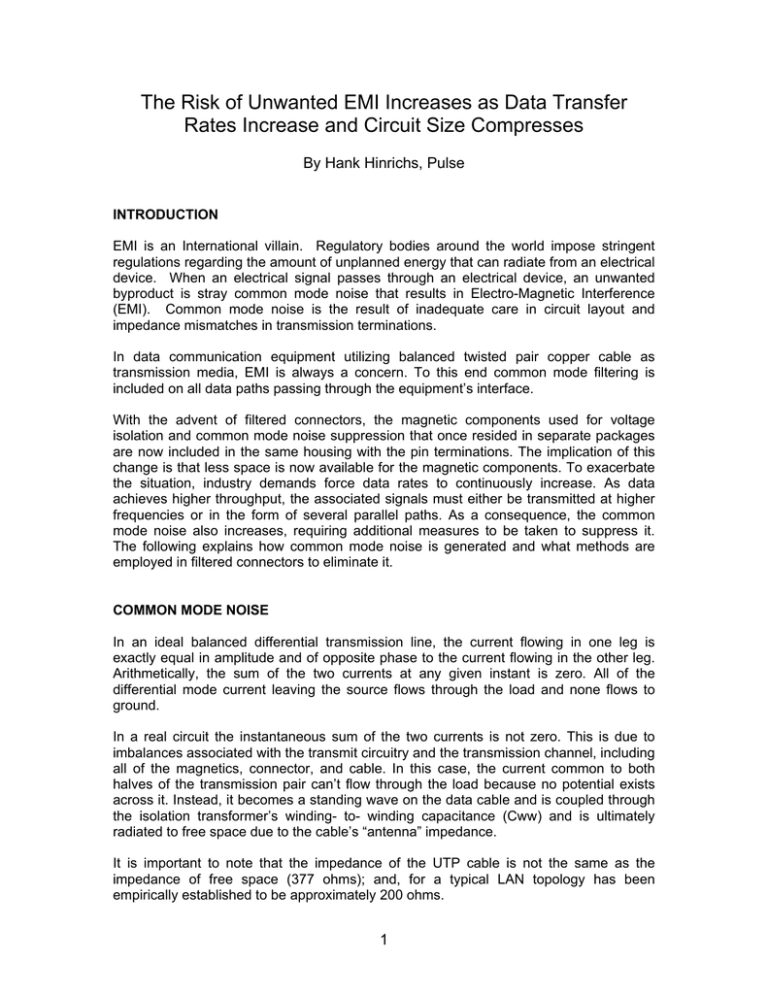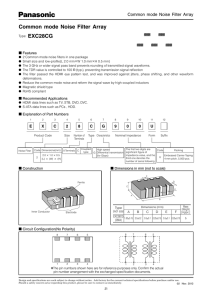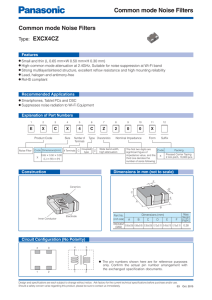G211 - Pulse Electronics
advertisement

The Risk of Unwanted EMI Increases as Data Transfer Rates Increase and Circuit Size Compresses By Hank Hinrichs, Pulse INTRODUCTION EMI is an International villain. Regulatory bodies around the world impose stringent regulations regarding the amount of unplanned energy that can radiate from an electrical device. When an electrical signal passes through an electrical device, an unwanted byproduct is stray common mode noise that results in Electro-Magnetic Interference (EMI). Common mode noise is the result of inadequate care in circuit layout and impedance mismatches in transmission terminations. In data communication equipment utilizing balanced twisted pair copper cable as transmission media, EMI is always a concern. To this end common mode filtering is included on all data paths passing through the equipment’s interface. With the advent of filtered connectors, the magnetic components used for voltage isolation and common mode noise suppression that once resided in separate packages are now included in the same housing with the pin terminations. The implication of this change is that less space is now available for the magnetic components. To exacerbate the situation, industry demands force data rates to continuously increase. As data achieves higher throughput, the associated signals must either be transmitted at higher frequencies or in the form of several parallel paths. As a consequence, the common mode noise also increases, requiring additional measures to be taken to suppress it. The following explains how common mode noise is generated and what methods are employed in filtered connectors to eliminate it. COMMON MODE NOISE In an ideal balanced differential transmission line, the current flowing in one leg is exactly equal in amplitude and of opposite phase to the current flowing in the other leg. Arithmetically, the sum of the two currents at any given instant is zero. All of the differential mode current leaving the source flows through the load and none flows to ground. In a real circuit the instantaneous sum of the two currents is not zero. This is due to imbalances associated with the transmit circuitry and the transmission channel, including all of the magnetics, connector, and cable. In this case, the current common to both halves of the transmission pair can’t flow through the load because no potential exists across it. Instead, it becomes a standing wave on the data cable and is coupled through the isolation transformer’s winding- to- winding capacitance (Cww) and is ultimately radiated to free space due to the cable’s “antenna” impedance. It is important to note that the impedance of the UTP cable is not the same as the impedance of free space (377 ohms); and, for a typical LAN topology has been empirically established to be approximately 200 ohms. 1 DIFFERENTIAL TO COMMON MODE CONVERSION As stated earlier in a differential circuit, if the two signal paths are not the same, the generated electro-magnetic fields will not be exactly equal and opposite and so will not exactly cancel. This process is called “Differential to Common Mode Conversion” and represents the circuit’s imbalance expressed as a ratio of the common mode signal resulting from a differential mode signal. In transformers, this is caused by longitudinal balance which is a measure of how well the transformer’s center tap is positioned with respect to the associated winding. SERIES COMMON MODE CHOKE All filtered connectors contain some form of common mode suppression. A typical implementation contains both series and shunt chokes (Figure 1) to attenuate and divert the common mode energy to chassis ground. Figure 1 The series common mode choke is placed in-line with the transmission path and is phased such that in the case of the differential signal the two windings oppose one another and cause minimal attenuation. However with signals that are common to both legs of the transmission path, the two windings aid one another forming an attenuation network having the following relationship: 200 Vout = Vin 2 • Π • f • L + 200 Where L f 200 = = = Inductance of one winding Frequency in hertz Approximate cable impedance In a series choke, its impedance at any given frequency is determined by the core material’s permeability and geometry and the number of turns used in the windings. In 2 an ideal choke, the core material’s permeability would be initially high and remain constant regardless of frequency and the winding’s distributed capacitance would be minimal. Unfortunately, beyond a certain frequency permeability begins to drop off regardless of what material is selected and distributed capacitance is always a factor and must be considered. Ultimately, it’s a tradeoff of the type of material selected, the size of the core that can be used, and how many turns can be employed without degrading the high frequency characteristics. SHUNT CHOKE A shunt choke consists of a center tapped single winding connected across the differential transmission path. The phasing of the two winding halves is such that the differential signal sees a large parallel inductive reactance at any pass-band frequency in comparison to the cable impedance. On the other hand, a common mode signal on the transmission lines has, as its return path, the center tap which is connected to ground. It is readily apparent from the equivalent circuit (Figure 2) that the two halves are in anti-phase and present a zero impedance to common mode signals. Figure 2 A shunt choke must be designed to have good longitudinal balance for the same reasons as the transformer. However, it is of equal importance that the path between the choke’s center tap and ground maintains low impedance. If, for example, this path has only 50 nanohenries of inductance, its impedance at 100 megahertz will be 31.4 ohms. For this reason a shunt choke is not an effective method of common mode suppression beyond 150 megahertz. SUMMARY In modern data communication equipment using unshielded twisted pair cabling, provisions must be taken to minimize the radiation of EMI. By understanding how common mode noise is generated, good design practices can be employed to eliminate or greatly reduce the level of common mode signals. As a last resort, filtered connectors can add to the solution through the use of both series and shunt chokes. 3


